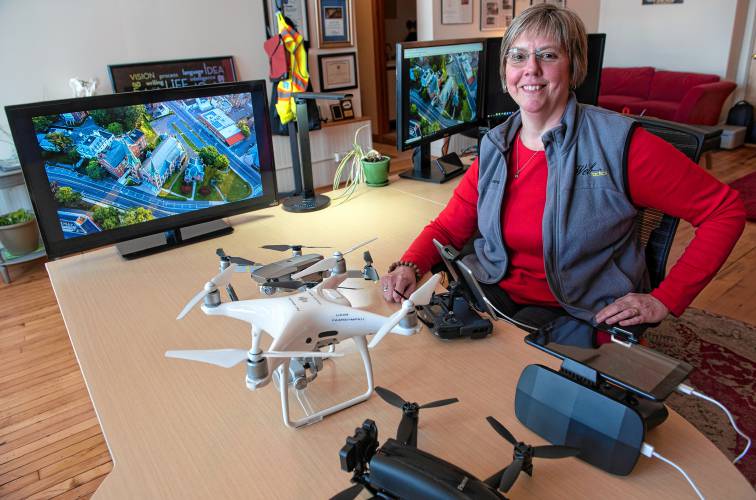 Mary’s Church in Northampton. STAFF PHOTO/CAROL LOLLIS » Janel Jorda, of Web-tactics,inc. in Easthampton, with her drones. STAFF PHOTO/CAROL LOLLI
Mary’s Church in Northampton. STAFF PHOTO/CAROL LOLLIS » Janel Jorda, of Web-tactics,inc. in Easthampton, with her drones. STAFF PHOTO/CAROL LOLLI
By LUIS FIELDMAN
Staff Writer
Published: 2/17/2019
High-flying, picturesque shots once reserved for multimillion-dollar Hollywood films have quickly become accessible for commercial and hobbyist drone pilots alike.
In just a few years, commercial drones have become a fad among the tech savvy, but they’ve also become an invaluable technology that has given established businesses an opportunity to broaden their services.
Drones, or unmanned aircrafts guided by remote control, have been used for military purposes since the 1980s, but there is a growing demand for videos and photos taken by flying cameras mounted on drones.
For real estate and landscaping companies, hiring a certified drone pilot to shoot videos and take photographs of their properties have revolutionized their marketing strategies.
The Federal Aviation Administration rolled out regulations for commercial drone pilots in 2016, and since then, there has been a rush from entrepreneurs to get certified. In order to obtain a remote pilot certificate from the FAA, pilots must be at least 16 years old and pass a written test.
Web-tactics in Easthampton, which provides web design and hosting services, was founded in 2004 by Janel P. Jorda. In 2017, she began blending drone videos and photos into her business model. She says the new products are a popular request from her customers, and the technology has brought new businesses knocking on her door.
“When you have a full agency like we do, you’ve got to go where technology goes,” Jorda said in a recent interview at her office at 83 Main Street.
Jorda is the only employee at her company, yet she works with a team of about 50 independent contractors including programmers, web designers, web developers. These experts help companies with their search optimization and social media presence.
“If a Realtor is selling a high-end property or a home situated on massive acreage, how could they even show that without us launching a drone above it showing the house and all the property that surrounds it?” Jorda asked.
Last June, Web-tactics made a video for a home in Westhampton on Montague Road for Northampton real estate agent Shelly Hardy, who said the video was “instrumental” in showing all 43 acres of the property.
Beginning at the home’s driveway, the video gives a sweeping view of the front of the property and as drone steadily rises, an extensive survey of the surrounding area as well.
Flying the drone, Jorda captured the backyard and its fenced-in pool and patio, a small shed, as well as a 100-foot shot of the house nestled in the woods — something that would’ve been practically impossible just five years ago before drones became commercially available.
“With the videos, it really puts you there,” Hardy said. “It’s the next stage of the virtual tour.”
The cost for drone services at Web-tactics start at $100.
The video also includes close-up shots around the home, and it enticed the eventual buyers enough to purchase the home. Since the buyers could not attend the open house, the drone video “really drew them in,” Hardy said.
“Nothing in this day and age can market these types of companies better than drone videography and photography,” Jorda said.
A growing industry
In January 2018, the U.S. Department of Transportation announced that the total number of drones registered with the FAA topped 1 million. This figure includes 878,000 hobbyists and 122,000 commercially licensed drone pilots.
In 2014, Glenn T. Labay bought his first drone, and he became a certified pilot in 2016.
“When I saw this technology coming, I knew it was important to establish myself early,” Labay said. In 2016, he founded Aerial Camera Services based in Southampton.
Since his first drone flight, he’s logged over 400 hours in the air. After two years of using his flying drones to film for real estate companies, he decided to switch gears and has begun using the technology for industrial mapping purposes.
Under the umbrella of Aerial Camera Services, he will have drone view reports for solar, construction and inspections services, which will provide pre-construction land surveys with GPS technology.
“It was a big step to get above the fray in terms of trying to provide a real service,” Labay said. He recently returned from training in South Carolina where he learned how to create 3-D models using drones.
Mapping for construction sites using drones has numerous benefits. Con Edison, an energy company headquartered in New York, has hired Labay to construct 3-D models of a site that the company is planning on building a solar array.
By using the drones to survey sites in Marbletown and Hawthorne, both in New York, Labay can create 3-D models that will show what the solar fields will look like. He will also keep track of the construction progress using his flying cameras.
Labay’s pre-construction survey photography will also allow Con Edison to develop renderings that they can bring to town hall meetings to present what the proposed site will look like when complete.
Labay has also converted a 2003 Dodge Ram 1500 van into a mobile, solar-powered studio on wheels so that he can upload his drone videos right from a site, which he calls the Scoob.
“I can sit with a client in there, review the shots on-site,” Labay said. “I’ve got it rigged up with solar panels so I can charge batteries without running the motor.”
Many uses
At Web-tactics, Jorda has also broadened her use of flying drones beyond real estate and landscaping. Using thermal imaging cameras, Jorda can help detect heating inefficiencies in hard to reach areas of a building.
“The pilot can reach that inaccessible part of the building, take photographs and videos, and then switch to the thermal part where we are showing them, in thermal grading, where the damage is and where the heat loss is,” Jorda said.
Instead of hiring a company and having somebody climb up a scaffold, Jorda said a drone cuts out the potential risk of injury and falling.
In 2016, falls accounted for 384 of the 991 deaths in the construction industry, according to the Occupational Safety and Health Administration.
“It’s not only savings of a lot of money for the building owner, but it’s also a wonderful safety,” Jorda said.
Luis Fieldman can be reached at lfieldman@gazettenet.com


